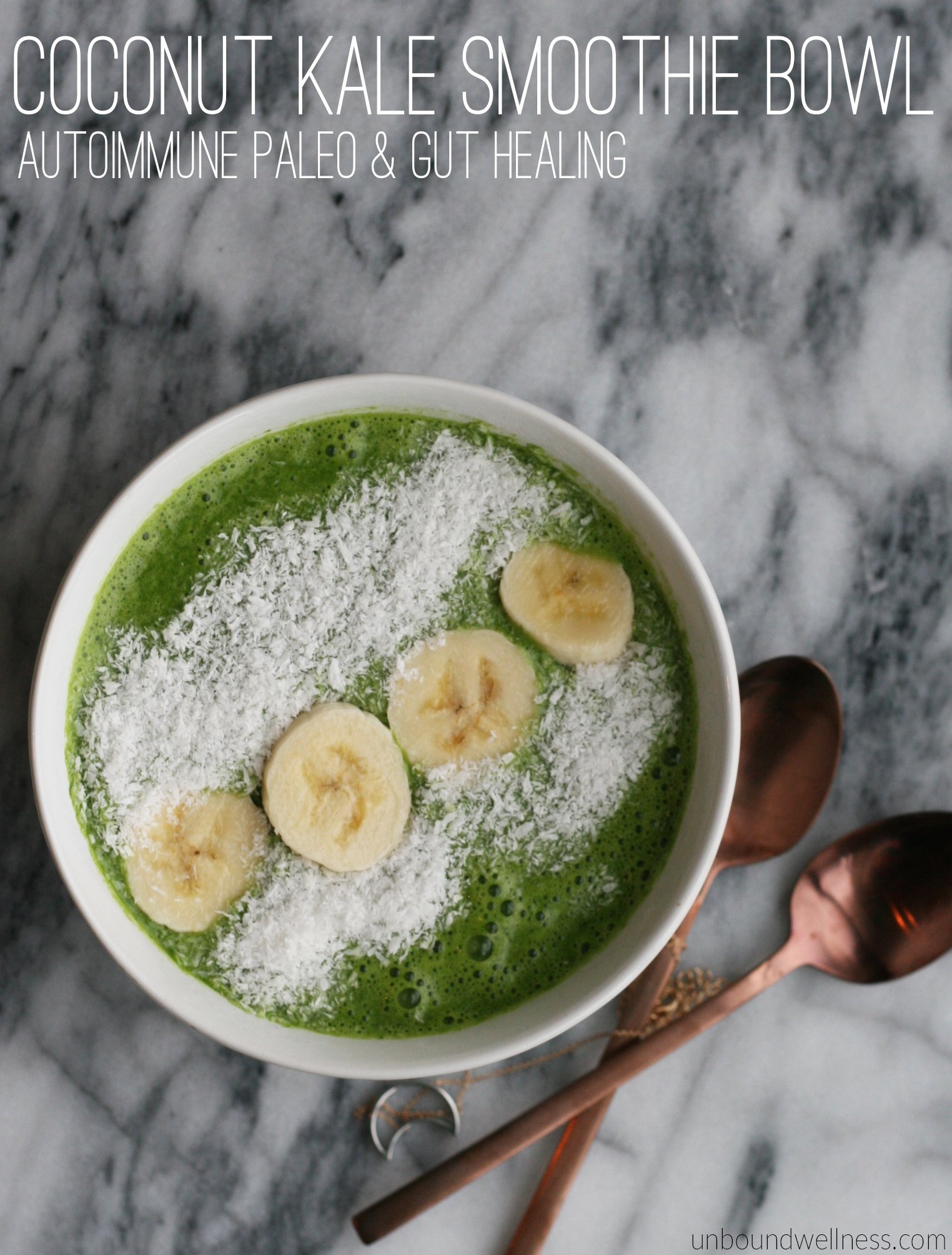Coconut Kale Green Smoothie Bowl | AIP and Gut Healing
This post contains affiliate links. Learn what that means here.
Have you ever seen those big beautiful smoothies on Instagram? The ones that are just overflowing from a mason jar or have a mosaic of toppings in a bowl? They look so beautiful, so fresh, and most of the time… pretty full of sugar. If you actually take a good look at the recipes that go along with these popular green smoothie bowls or juices, they’re usually packed with sugar, scarce on veggies, and almost always void of healthy fats and protein. But, it doesn’t have to be that way! That’s why I created a nourishing smoothie bowl thats packed with all the good stuff while still being full of flavor.
Smoothies can be one of those pseudo-health foods that seem healthy, but can have just as much sugar as a soda if not more if not made properly. So, what does a good, nutrient dense smoothie need?
Mostly veggies. Especially leafy greens! Smoothies are a great way to get in lots of leafy greens. Have as many veggies as you want in your smoothies!
Moderate fruit. Fruit may be natural sugar, but it’s still sugar. And in excess, it’s still going to swing your blood sugar and not satiate you. If you’re relying on mostly fruit to make your smoothie, I guarantee that you’ll be hungry soon after and craving more sugar. In nature, we didn’t have much need for more than 2 servings of fruit a day. However, smoothies can easily have 3-4 servings of fruit along with sugar-y juice that’s void of fiber. Try sticking to one serving of fruit in a smoothie and using something like a frozen banana, or fresh berries.
Healthy Fats. Fat is usually the big thing that’s missing from most smoothies. Healthy fats like avocado and coconut oil are a great addition to a smoothie, and are what actually satiates us. Adding a tablespoon of fat to your smoothie will help keep you full.
Good quality protein. Extra protein is a great addition to a smoothie, but be cautious of poor quality powders. Many protein powders can be filled with sugar, fake ingredients, and soy. I like adding grass-fed collagen to my smoothies. It doesn’t add any funky taste either! Collagen from grass-fed cows is also great for gut healing as helps to restore the intestinal lining that is often destroyed by leaky gut. Get some here!
It’s also important to note that I say smoothies not juices. Juices can be great in moderation if you’re juicing mostly vegetables, but when we’re talking fruit juice, it’s a huge shot to your blood sugar.
Now that we’ve got all of the essentials laid out, let’s put them all together in my coconut kale smoothie bowl!


Coconut Kale Smoothie Bowl | Autoimmune Paleo and Gut Healing
Want to save this for later?
Just drop your name and email below. Then we’ll email right to your inbox. ✉️
Ingredients
- 3-4 large kale leaves, destemed
- 2 frozen peach slices
- 1 cup coconut milk
- 1 tbsp coconut oil
- 1 tbsp collagen hydrolysate
- 3 ice cubes
- Juice from 1/4 lemon
- Optional Topping
- ½ banana sliced
- 1 tbsp coconut flakes
Instructions
- Add the kale and coconut milk to the blender (vitamin, ninja, nutribullet, etc) and blend until smooth
- Add other ingredients and blend until smooth and all frozen chunks are broken up
- Pour smoothie into a bowl (or cup if preferred)
- Add toppings as desired
- Eat with a spoon and enjoy!
I highly recommend trying this out if you’re looking for a cold treat, or are struggling to get extra leafy greens into your diet. Not only is it nutrient dense, but it’s so much fun to eat!
Do you make smoothie bowls? What are you go-to toppings?
This recipe was shared on the Pheonix Helix Recipe AIP Recipe Roundtable. Go check it out!


looks good, and i like that your website keeps popping up every time i look for something with the tag “AIP”.
as a note for the recipe, avacado is another really good healthy fat and it goes well with the coconut and banana. not sure about this with peach though, maybe a different frozen fruit like blueberries.
I was researching and see that Raquel is not good for people with thyroid problems.
Do you use canned coconut milk?
I like native forest “simple” canned 🙂
Love all your recipes, I submitted for your recipe book, and paid $18 dollars but yet have not received it
Thank you Lorena!! Can you please email me your receipt?? I can get you the book there 🙂 unboundwellness @ gmail.com
Girl this looks amazing! (I forgot to tell you over workshop weekend, you got me started on carob powder, I miss the chocolate, but get way to stimulated from it) thanks so much for the inspiration.
Thanks so much, Julie!!! Glad that you love the carob powder. That stuff is my life line at times haha!
I have never made a smoothie bowl, probably because they are always made with lots of fruit, but I’m really liking your kale and coconut one! I’ll have to check out that grassfed collagen hydrolysate too 🙂
Thanks, Karrie! I love, love, love the collagen!